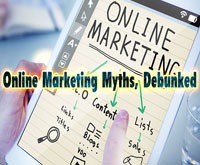You probably already know that marketing your business online can help you reach as many potential customers as possible. However, not every online marketing tactic may be helpful for your business even if competitors are using the same; but, it doesn’t mean it wouldn’t work at all.
The dynamics of digital marketing is constantly evolving, so you need to research and observe regularly to be able to apply what works best for your own business. But first, you need to learn not to trust everything you hear about online marketing. We are going to dispel myths you should know about online marketing.
 1. You can measure the success of your online marketing tactic by looking at website traffic.
1. You can measure the success of your online marketing tactic by looking at website traffic.
Getting high levels of website traffic is important to gain higher search rankings, but it doesn’t mean you are getting it right. Quality is still greater than quantity. The traffic must be bringing a benefit for your website and more importantly to your business for it to be relevant. Getting only 300 visitors, which 30 of them checking out your product or service offerings, plus some of them actually buying or subscribing, is better than getting 3,000 visitors but only 10 do such actions. This is where setting a clear target market and tailoring content to suit them become helpful and important.
 2. Online marketing is a luxury for small businesses.
2. Online marketing is a luxury for small businesses.
Some businesses, especially the smaller ones, overlook the value of going digital on marketing because they consider it as a hassle and additional expense that doesn’t ensure concrete returns. What they tend to overlook is that most buyers check out their to-buy items online, searching for information and comparing brands and prices, so those businesses with online presence gain an advantage. Plus, those who establish their brand on social media and build rapport with their audience are more likely to get ahead in the market compared to those who do not.
 3. Getting a website up and running means your work on online marketing is almost done.
3. Getting a website up and running means your work on online marketing is almost done.
We will not belittle the efforts exerted on creating a cool website, but getting it live is not enough. Real work actually starts after the website is launched. You need to create awareness about the website, update it with relevant content and information and optimize it for better visibility on search engines. A website that regularly brings new content creates a positive appeal to your target audience. Customers immediately exit websites whose blogs or posts were not been updated since 2014.
However, the constant need to update doesn’t always apply in all areas. While it is true that a website that is good-looking and pleasing to the eye gains people’s attention and trust, regular updating of web design might not earn you customer loyalty. There is no need to frequently re-design unless it there is data, like collective customer feedback, that justifies the need to update the design.
 4. B2B does not need social media marketing.
4. B2B does not need social media marketing.
Social media can be an efficient channel for any industry, whatever nature it is. Some business owners believe that the only effective online channel for B2B marketing is traditional web advertising. They don’t consider social media because they see it as a consumer haven only, not a place where other people behind B2B are present. But actually, leveraging social media platforms would be a great way for B2B organizations to find and nurture leads and to discover new deal opportunities.
 5. Use every social media platform to gain a larger audience and more customers.
5. Use every social media platform to gain a larger audience and more customers.
Each social media platform is made unique for a reason – you will benefit from it in different ways. Their uniqueness must be considered when planning and executing an online marketing strategy. Find where your target market is, and consider only the platforms that will be helpful and relevant for your brand. You don’t need to waste time, money and resources on using a platform that does not reach your potential customers. For instance, it might be useless for an accounting firm to utilize Instagram and Pinterest as a marketing tool, but a fashion brand can gain a lot with using those platforms.
6. Social media is too noisy for content to rise and to create an impact.
While some believe the earlier myth, there are others who think the opposite way: they avoid social media because there is already too much information, making it hard to gain attention and reach its target market. While it is true that gaining quality attention is challenging when the whole world is online 24/7, a successful connection with your target market can still be achieved by implementing a well-planned strategy. Create valuable and click-worthy content by posting useful information for your audience, engage them in discussions and use analytics to discover the best times to post. Having an effective strategy will certainly help you get noticed by your target audience.
7. Don’t bother getting online if your target market is the older generation.
Reports show that the younger generation is gradually leaving Facebook for other social networking sites like Twitter, Instagram, and Snapchat. Currently, the majority of people who regularly use Facebook are 25 to 55-year-olds. Almost everyone, no matter their age, is going social now. However, it is still important to research on the best platform to use for greater visibility (but we think we already gave you a clue), and plan a strategy for better consumer engagement.
8. Bad publicity in social media can surely bring your business down.
Tons of negative customer feedback reflected on social media can be too painful to handle for a business, especially for its marketers. However, untoward situations like this can be considered as a perfect opportunity to show the reliability of your customer service. Don’t hide or delete legitimate customer complaints; instead, provide a thoughtful response and give them an option to call or email your customer service personnel for further assistance. The more you invest in connecting to customers and providing them solutions, the more you will gain loyalists who can defend your brand to those who will speak ill of it. The customers you’ve served satisfactorily after a drawback can turn into effective brand advertisers for you – free of charge.


 1. You can measure the success of your online marketing tactic by looking at website traffic.
1. You can measure the success of your online marketing tactic by looking at website traffic. 2. Online marketing is a luxury for small businesses.
2. Online marketing is a luxury for small businesses. 3. Getting a website up and running means your work on online marketing is almost done.
3. Getting a website up and running means your work on online marketing is almost done. 4. B2B does not need social media marketing.
4. B2B does not need social media marketing. 5. Use every social media platform to gain a larger audience and more customers.
5. Use every social media platform to gain a larger audience and more customers.